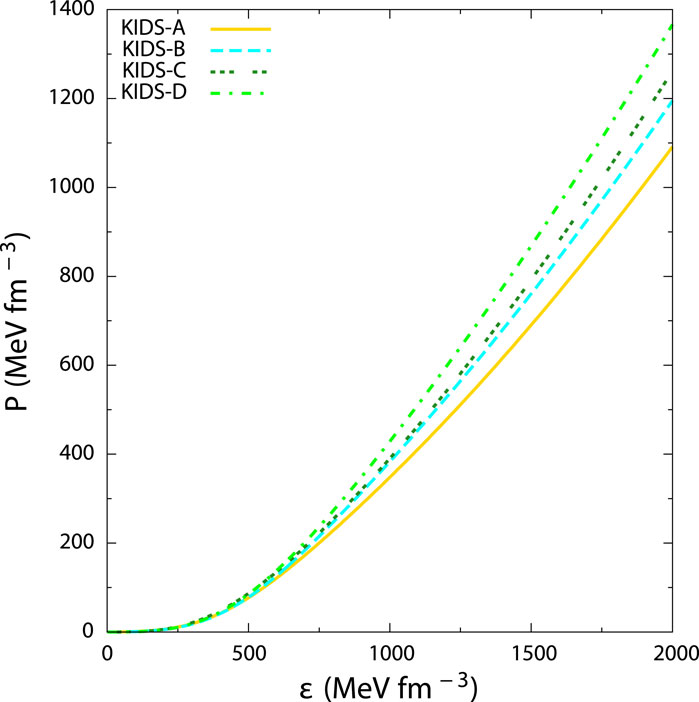- 1Center of Extreme Nuclear Matters, Korea University, Seoul, Republic of Korea
- 2Department of Physics Education, Daegu University, Gyeongsan-si, Republic of Korea
Employing the Korea-IBS-Daegu-SKKU (KIDS) density functional for the hadron phase and the MIT bag model with vector (vBag) model for the quark phase, we obtain hadron-quark phase transition in neutron stars considering Maxwell construction. The structural properties of the resultant hybrid stars are computed for three different values of bag constant
1 Introduction
Mass-radius
A naive but quite certain scenario is the phase transition from hadronic matter to quark matter. Initially the matter is composed of nucleons at low densities, where they are far apart. Since the nucleon has a finite size, they start to overlap to each other at a density higher than the saturation. As the density evolves furthermore, confinement of quarks in the initial nucleon becomes uncertain, and finally quarks are completely released from the nucleons and form a deconfined quark matter. The key points to the hadron-quark phase transition are the physical properties of the nucleon and quarks, and their interactions at finite densities. The main concern of the present work is to examine the effect of the uncertainties in the interactions of quarks and nucleons to the equation of state (EoS) and the phase transition in the core of neutron stars, forming hybrid stars. For the calculation of the EoS, we use the MIT bag model with vector repulsion (vBag) (Kumar et al., 2022; Lopes et al., 2022; Kumar et al., 2023; Laskos-Patkos et al., 2023) for the quark matter, and the Korea-IBS-Daegu-SKKU (KIDS) density functional (Gil et al., 2021; Gil and Hyun, 2021; Gil et al., 2022) for the hadron phase. Phase transition is achieved with the help of Maxwell construction assuming that the surface tension of the interface is high enough (
In the vBag model, stiffness of the quark matter is controlled by the bag constant and the vector repulsion (Kumar et al., 2022; Lopes et al., 2022; Kumar et al., 2023; Laskos-Patkos et al., 2023). The two quantities have different physical origins and implications. Bag constant is introduced in the original bag model. In the simplest description of the baryon bags, quarks are treated as free particles within a bag. In order to confine the quarks within the baryon, inward pressure is assumed to be exerted on the quarks. The inward pressure is described in terms of the bag constant, so it is a natural way to determine the bag constant from the baryon masses in free space. In this work, as a lower limit of the bag constant, we adopt
While the bag constant is inherent in the bag model, there is no repulsive force in the original bag model. The reason might be that it is sufficient to produce the baryon spectrum accurately with the kinetic energy of quarks and the bag constant. With these two ingredients, however, it is hard to satisfy the observation of large mass stars,
In the description of neutron-rich hadronic matter, the largest uncertainty comes from the symmetry energy. Its value at the saturation density is relatively accurately determined, most conservatively in the range 30
In the calculation of the EoS, we treat the bag constant as a free parameter, and determine the range of vector coupling constants to satisfy the data of GW170817, NICER and HESS simultaneously for the given models of the symmetry energy. In the result, we find that the critical density at which the phase transition occurs is sensitive the bag constant, vector coupling constant and the symmetry energy. However, maximum mass depends on the bag constant and the symmetry energy weakly, so we can obtain appreciably model-independent range of the vector coupling constant.
We organize the work in the following order. In Section 2, models for the quark and hadronic matters are described. Section 3 shows the results and we present the discussions on them. The work is summarized in Section 4.
2 Model
2.1 MIT bag with vector repulsion
We consider quark matter with
where
2.2 KIDS functional
In the KIDS density functional framework, energy of a nucleon in nuclear matter is expanded in powers of
In Eq. 2,
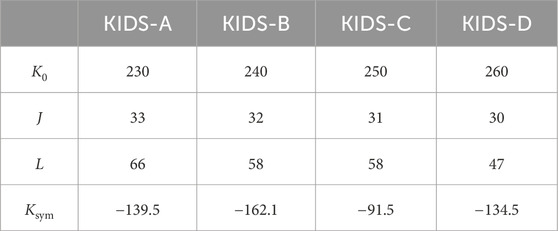
Table 1. Incompressibility
2.3 Phase transition
In the present work, phase transition is achieved via Maxwell construction assuming that the surface tension at the hadron-quark interface is sufficiently large (Maruyama et al., 2008). Maxwell construction is based on the local charge neutrality condition which implies that both the hadronic (H) and quark (Q) phases must be individually charge neutral,
Following Maxwell criteria, phase transition occurs when the pressure
In case of Maxwell construction, based on Eqs 3, 4,
The resultant hybrid EoS is employed to obtain the mass
3 Result
We first examine the dependence of symmetry energy on the properties of hadronic stars with the four different KIDS models with different symmetry energy as tabulated in Table 1. For the hadronic model, as the symmetry energy
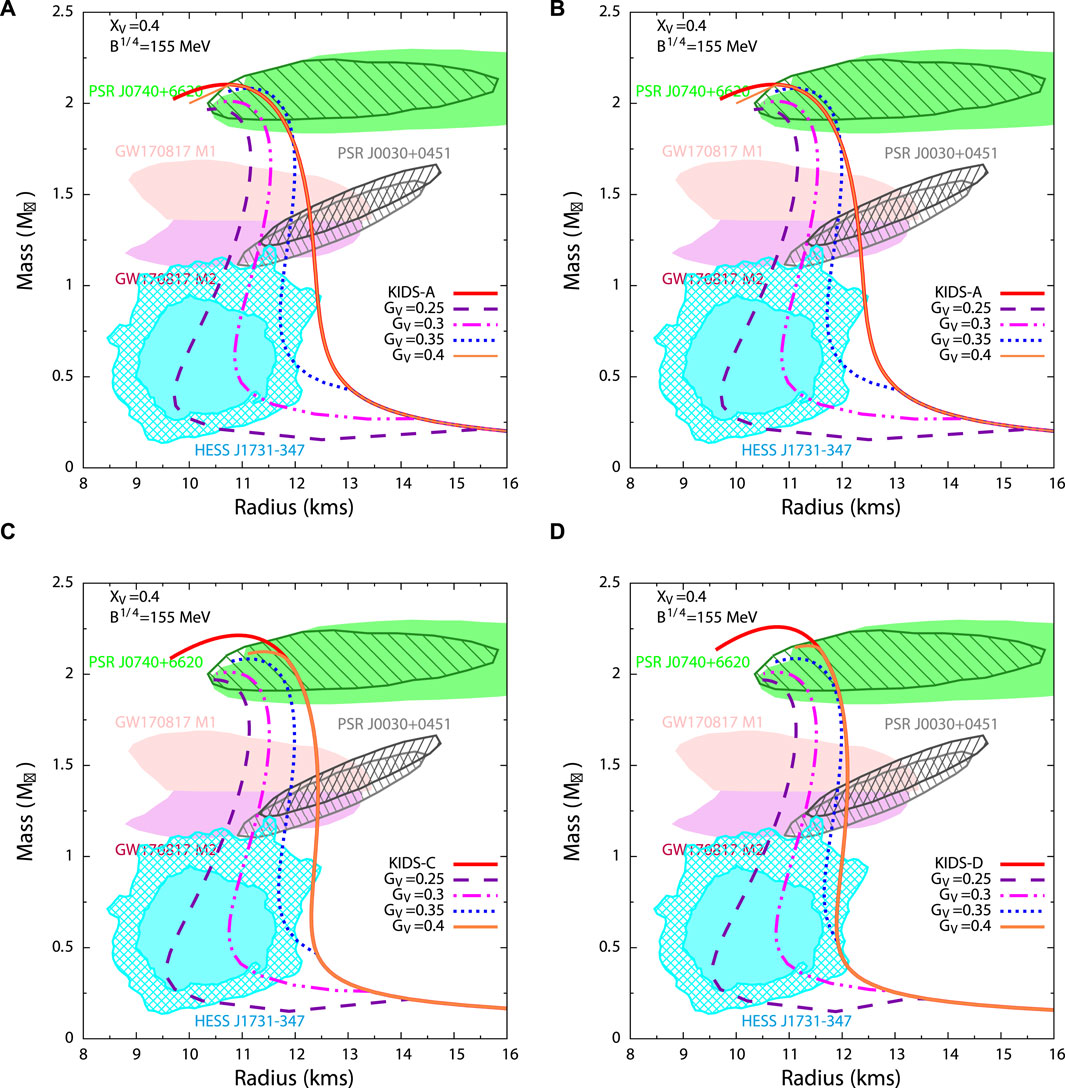
Figure 2. Variation of mass with radius of hadronic star (solid lines) and hybrid stars (dashed lines) with hadronic models (A) KIDS-A, (B) KIDS-B, (C) KIDS-C and (D) KIDS-D for different values of
In order to study the influence of symmetry energy on the phase transition and the hybrid star structure, we consider the vBag model with
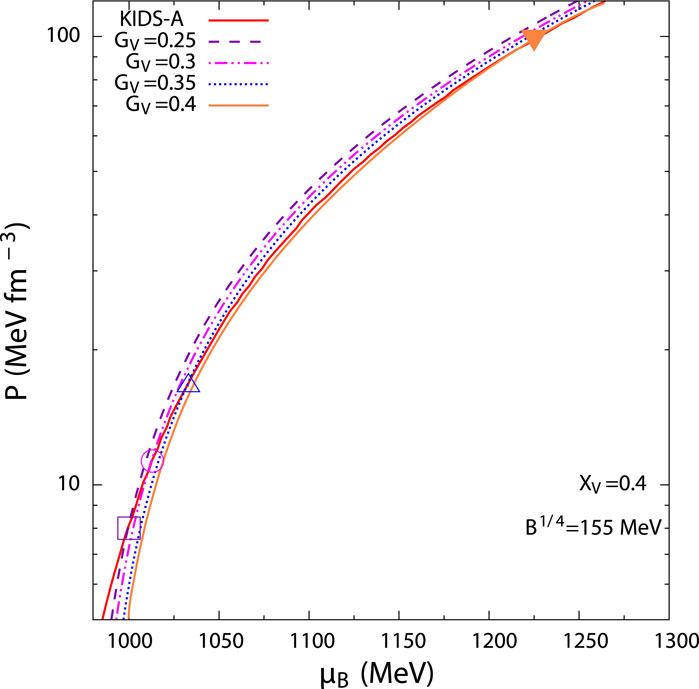
Figure 3. Variation of pressure as a function of baryon chemical potential for hadronic matter with KIDS-A model and quark matter for different values of
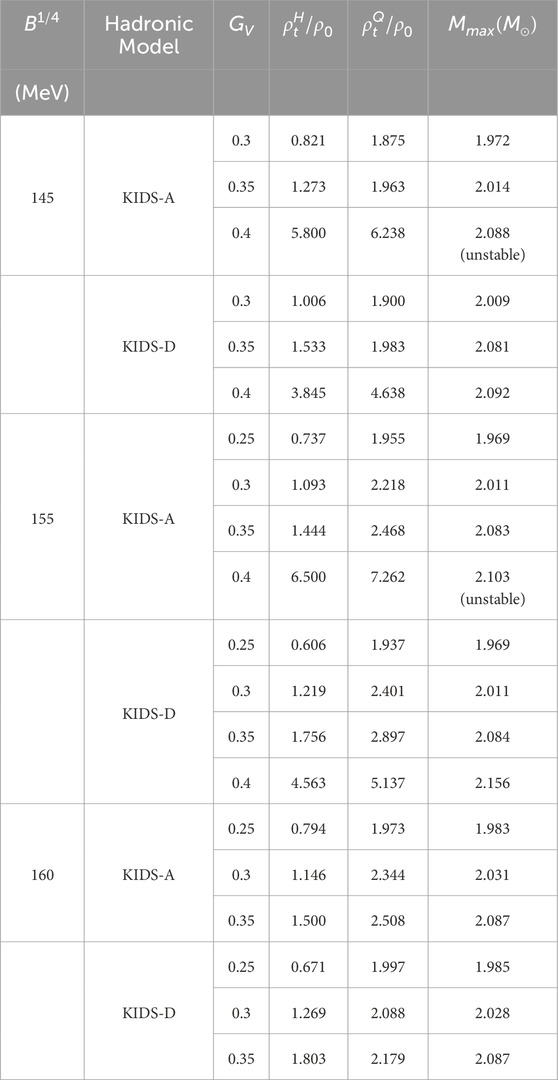
Table 2. Comparison of hadron-quark transition densities, and maximum mass for different
As a result we observe in Figures 2A–D that for any particular hadronic model, the maximum mass and corresponding radius of the hybrid stars increase with increasing repulsion via
We show the dependence of transition properties like
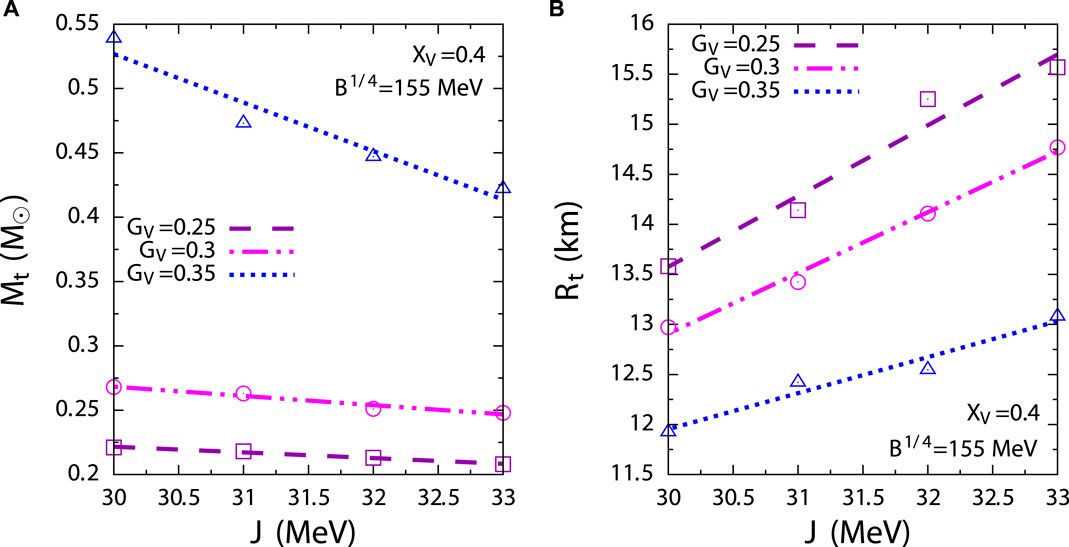
Figure 4. Variation of (A) transition mass and (B) transition radius of hybrid stars with respect to symmetry energy for different values of
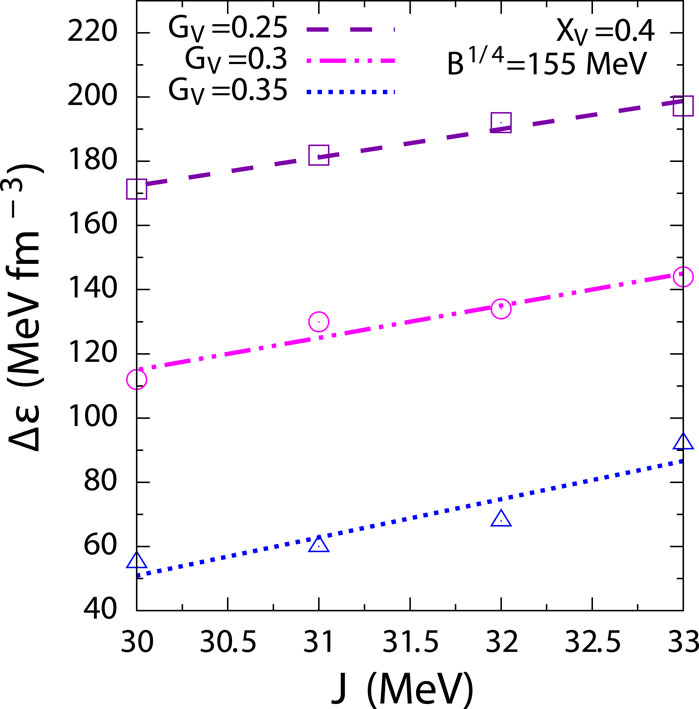
Figure 5. Variation of jump in energy density of hybrid stars with respect to symmetry energy for different values of
We also study the variation of the dimensionless tidal deformability with the canonical mass of hadronic and hybrid stars in Figure 6, where it is seen that the values of
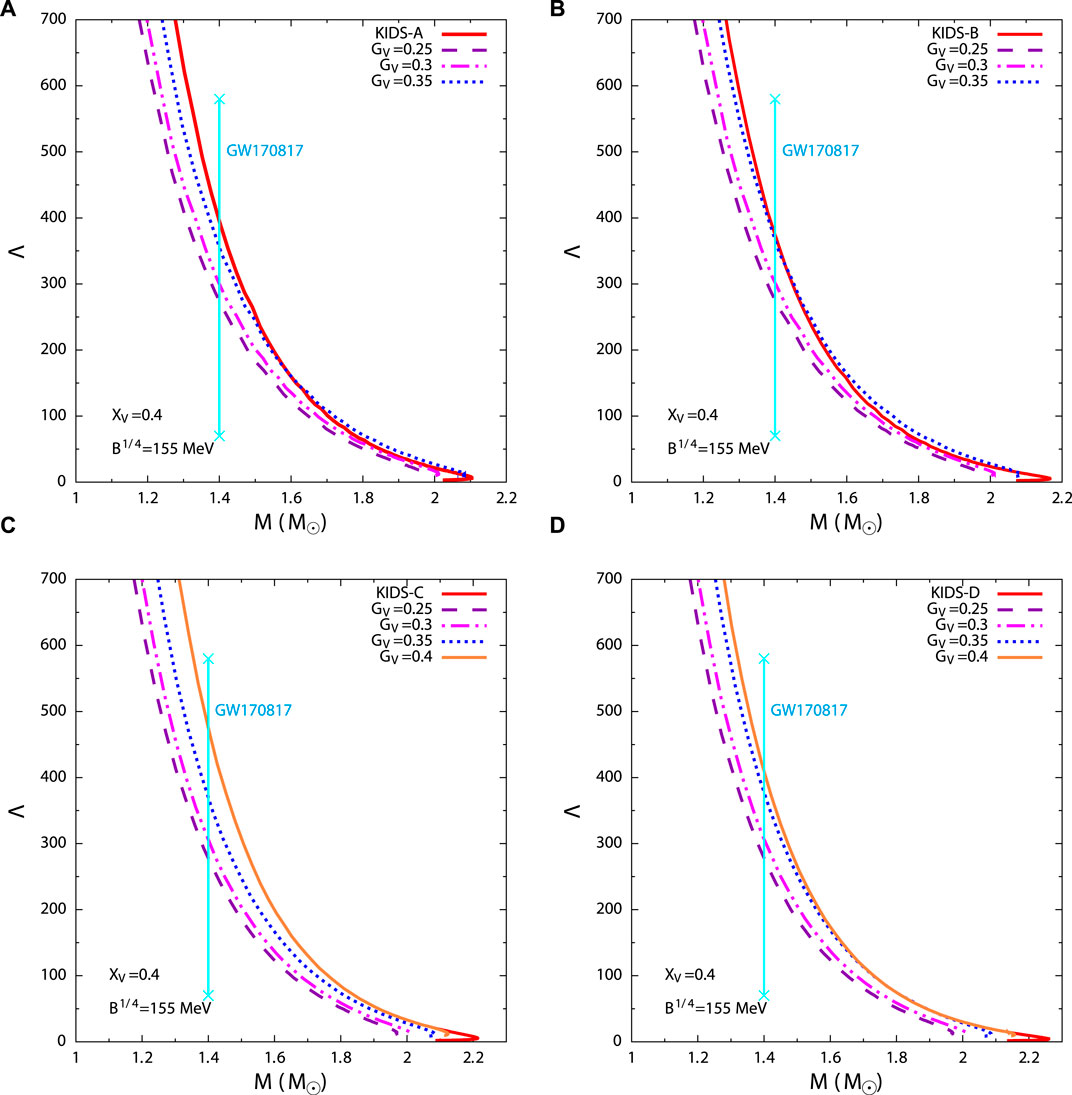
Figure 6. Variation of tidal deformability with mass of hadronic star (solid lines) and hybrid stars (dashed lines) with hadronic models (A) KIDS-A, (B) KIDS-B, (C) KIDS-C and (D) KIDS-D for different values of
We next consider a lower value of
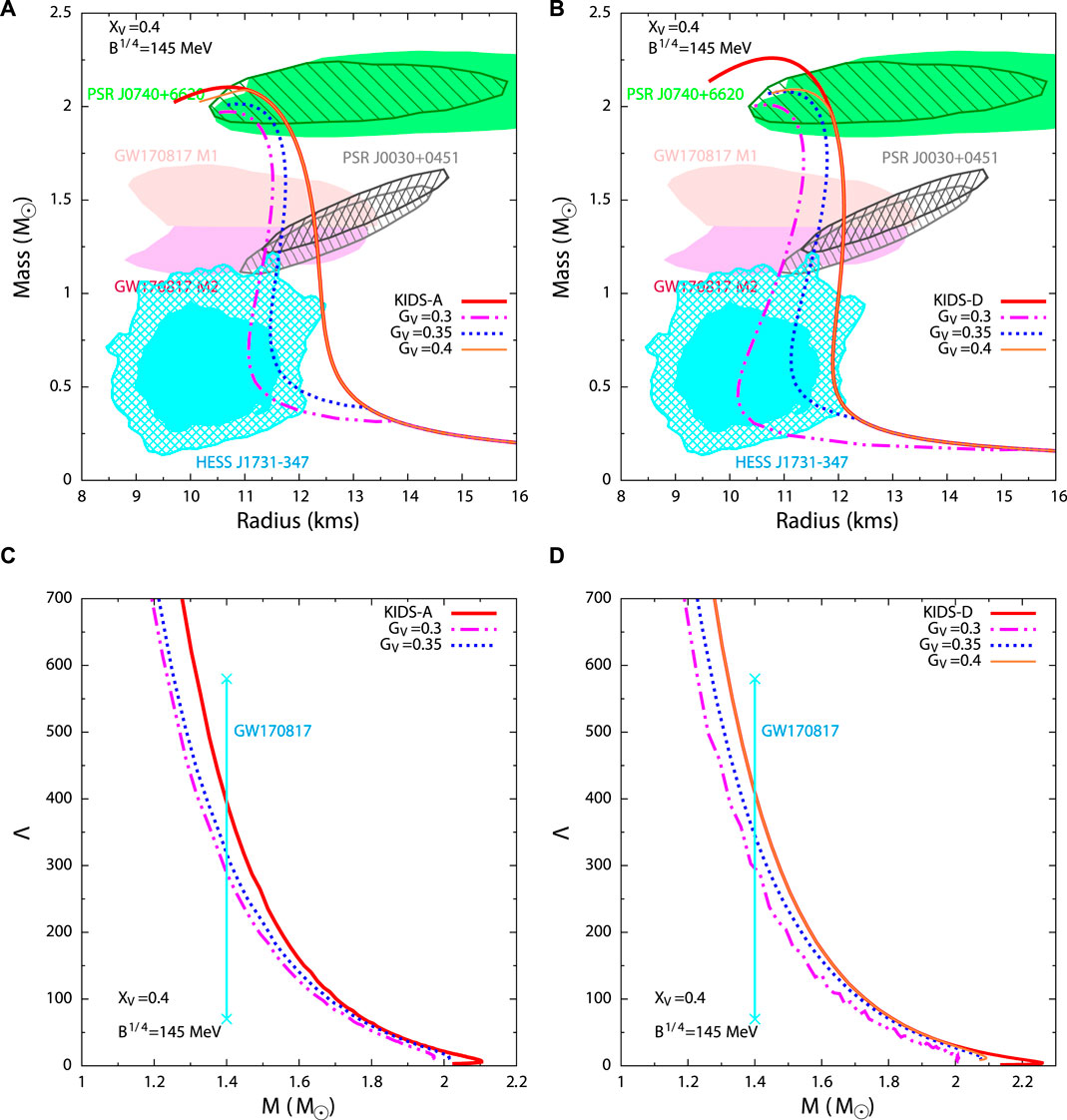
Figure 7. Variation of mass with radius (A,B) and tidal deformability with mass (C,D) of hadronic star (solid lines) and hybrid stars (dashed lines) with hadronic models KIDS-A and KIDS-D for different values of
We finally consider a higher value of
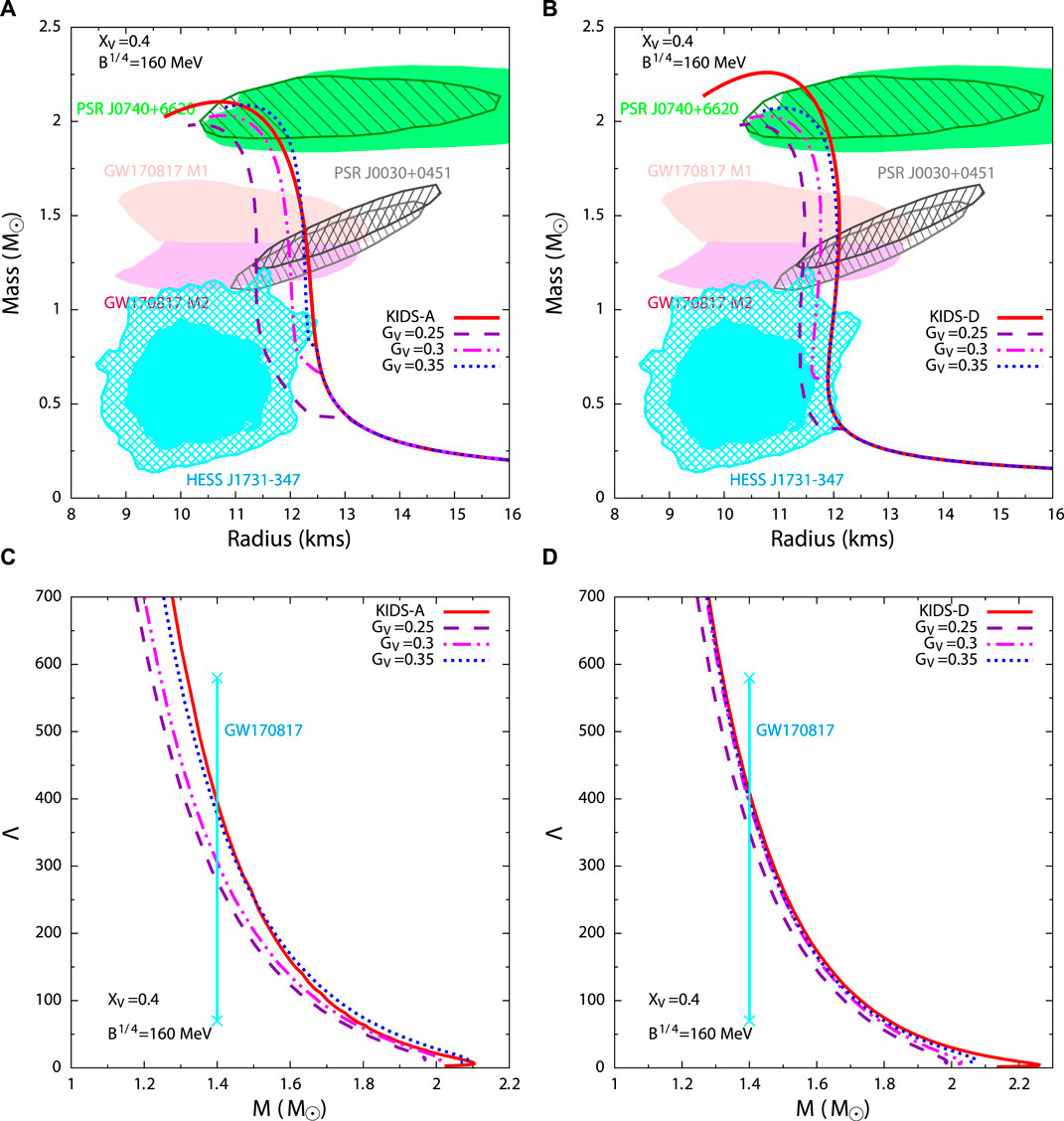
Figure 8. Variation of mass with radius (A,B) and tidal deformability with mass (C,D) of hadronic star (solid lines) and hybrid stars (dashed lines) with hadronic models KIDS-A and KIDS-D for different values of
In Table 2 we display the transition densities and the maximum mass of the various hybrid star configurations. At the saturation density
4 Summary
The present work is dedicated to study hadron-quark phase transition and the structural properties of hybrid stars. They depend on the properties of both the hadronic and quark phases like the symmetry energy of the former and the bag constant and the strength of quark repulsion of the latter. In order to investigate the effects of symmetry energy on the hybrid star properties we consider four KIDS models with different symmetry energy while the vBag model is adopted for the quark phase to study the influence of quark repulsion via the different values of vector coupling
We found that for any particular value of
For any particular value of
For fixed values of
In recent literature, it is shown that the consideration of extensive microscopic methods for the hadronic and quark matter suggests that the crossover transition is more likely to happen than the strong first-order transition in the core of neutron stars (Constantinou et al., 2021; Huang et al., 2022; Qin et al., 2023; Sotani and Kojo, 2023). Therefore, it will be interesting to study the possibilities of such crossover transition in neutron stars in our near future projects.
Data availability statement
The original contributions presented in the study are included in the article/Supplementary Material, further inquiries can be directed to the corresponding author.
Author contributions
DS: Conceptualization, Writing–original draft, Writing–review and editing, Formal Analysis, Visualization. HG: Formal Analysis, Writing–review and editing, Data curation, Investigation. CH: Writing–review and editing, Conceptualization, Methodology, Writing–original draft.
Funding
The author(s) declare that financial support was received for the research, authorship, and/or publication of this article. This work was supported by the National Research Foundation of Korea (Grant Nos 2018R1A5A1025563 and 2023R1A2C1003177).
Conflict of interest
The authors declare that the research was conducted in the absence of any commercial or financial relationships that could be construed as a potential conflict of interest.
Publisher’s note
All claims expressed in this article are solely those of the authors and do not necessarily represent those of their affiliated organizations, or those of the publisher, the editors and the reviewers. Any product that may be evaluated in this article, or claim that may be made by its manufacturer, is not guaranteed or endorsed by the publisher.
References
Abbott, B. P., Abbott, R., Abbott, T., Acernese, F., Ackley, K., Adams, C., et al. (2018). GW170817: measurements of neutron star radii and equation of state. Phys. Rev. Lett. 121, 161101. arXiv:1805.11581 [gr-qc]. doi:10.1103/physrevlett.121.161101
Baym, G., Pethick, C., and Sutherland, P. (1971). The ground state of matter at high densities: equation of state and stellar models. Astrophys. J. 170, 299. doi:10.1086/151216
Constantinou, C., Han, S., Jaikumar, P., and Prakash, M. (2021). g modes of neutron stars with hadron-to-quark crossover transitions. Phys. Rev. D. 104 (12), 123032. doi:10.1103/physrevd.104.123032
Contrera, G. A., Ranea-Sandoval, I. F., and Weber, F. (2017). Hybrid stars in the framework of NJL models. Int. J. Mod. Phys. Conf. Ser. 45, 1760026. arXiv:1612.09485 [nucl-th]. doi:10.1142/s2010194517600266
Doroshenko, V., Suleimanov, V., Puhlhofer, G., and Santangelo, A. (2022). A strangely light neutron star within a supernova remnant. Nat. Astron. 6, 1444–1451. doi:10.1038/s41550-022-01800-1
Fonseca, E., Cromartie, H. T., Pennucci, T. T., Ray, P. S., Kirichenko, A. Y., Ransom, S. M., et al. (2021). Refined mass and geometric measurements of the high-mass PSR J0740+ 6620. Astrophys. J. Lett. 915, L12. arXiv:2104.00880 [astro-ph.HE]. doi:10.3847/2041-8213/ac03b8
Gil, H., and Hyun, C. H. (2021). Compression modulus and symmetry energy of nuclear matter with KIDS density functional. New Phys. Sae Mulli 71, 242–248. arXiv:2012.00930 [nucl-th]. doi:10.3938/npsm.71.242
Gil, H., Kim, Y.-M., Papakonstantinou, P., and Hyun, C. H. (2021). Constraining the density dependence of the symmetry energy with nuclear data and astronomical observations in the Korea-IBS-Daegu-SKKU framework. Phys. Rev. C 103, 034330. arXiv:2010.13354 [nucl-th]. doi:10.1103/physrevc.103.034330
Gil, H., Papakonstantinou, P., and Hyun, C. H. (2022). Constraints on the curvature of nuclear symmetry energy from recent astronomical data within the KIDS framework. Int. J. Mod. Phys. E 31, 2250013. arXiv:2110.09802 [nucl-th]. doi:10.1142/s0218301322500136
Grill, F., Pais, H., Providência, C., Vidaña, I., and Avancini, S. S. (2014). Equation of state and thickness of the inner crust of neutron stars. Phys. Rev. C 90, 045803. arXiv:1404.2753 [nucl-th]. doi:10.1103/physrevc.90.045803
Hinderer, T. (2008). Tidal love numbers of neutron stars. Astrophys. J. 677, 1216–1220. arXiv:0711.2420 [astro-ph]. doi:10.1086/533487
Hinderer, T., Lackey, B. D., Lang, R. N., and Read, J. S. (2010). Tidal deformability of neutron stars with realistic equations of state and their gravitational wave signatures in binary inspiral. Phys. Rev. D. 81, 123016. arXiv:0911.3535 [astro-ph.HE]. doi:10.1103/physrevd.81.123016
Huang, Y.-J., Baiotti, L., Kojo, T., Takami, K., Sotani, H., Togashi, H., et al. (2022). Merger and postmerger of binary neutron stars with a quark-hadron crossover equation of state. Phys. Rev. Lett. 129 (18), 181101. doi:10.1103/physrevlett.129.181101
Kumar, A., Thapa, V. B., and Sinha, M. (2022). Compact star merger events with stars composed of interacting strange quark matter. Mon. Not. Roy. Astron. Soc. 513, 3788–3797. arXiv:2204.11034 [astro-ph.HE]. doi:10.1093/mnras/stac1150
Kumar, A., Thapa, V. B., and Sinha, M. (2023). Hybrid stars are compatible with recent astrophysical observations. Phys. Rev. D. 107, 063024. arXiv:2303.06387 [astro-ph.HE]. doi:10.1103/physrevd.107.063024
Laskos-Patkos, P., Koliogiannis, P. S., and Moustakidis, C. C. (2023). Hybrid stars in light of the HESS J1731-347 remnant and the PREX-II experiment. arXiv:2312.07113 [astro-ph.HE].
Laskos-Patkos, P., and Moustakidis, C. C. (2023). Signatures of quark deconfinement through the r-modes of twin stars. Phys. Rev. D. 107 (12), 123023. doi:10.1103/physrevd.107.123023
Li, J. J., Sedrakian, A., and Weber, F. (2020). Rapidly rotating Δ-resonance-admixed hypernuclear compact stars. Phys. Lett. B 810, 135812. doi:10.1016/j.physletb.2020.135812
Lopes, L. L., Biesdorf, C., and Menezes, D. P. (2022). Hypermassive quark cores. Mon. Not. Roy. Astron. Soc. 512, 5110–5121. arXiv:2111.13732 [hep-ph]. doi:10.1093/mnras/stac793
Maruyama, T., Chiba, S., Schulze, H. J., and Tatsumi, T. (2008). Quark deconfinement transition in hyperonic matter. Phys. Lett. B 659, 192–196. doi:10.1016/j.physletb.2007.10.056
Miller, M. C., Lamb, F. K., Dittmann, A. J., Bogdanov, S., Arzoumanian, Z., Gendreau, K. C., et al. (2019). PSR J0030+ 0451 mass and radius from NICER data and implications for the properties of neutron star matter. Astrophys. J. Lett. 887, L24. arXiv:1912.05705 [astro-ph.HE]. doi:10.3847/2041-8213/ab50c5
Miller, M. C., Lamb, F. K., Dittmann, A. J., Bogdanov, S., Arzoumanian, Z., Gendreau, K. C., et al. (2021). The radius of PSR J0740+ 6620 from NICER and XMM-Newton data. Astrophys. J. Lett. 918, L28. arXiv:2105.06979 [astro-ph.HE]. doi:10.3847/2041-8213/ac089b
Nandi, R., and Char, P. (2018). Hybrid stars in the light of GW170817. Astrophys. J. 857 (1), 12. doi:10.3847/1538-4357/aab78c
Oppenheimer, J. R., and Volkoff, G. M. (1939). On massive neutron cores. Phys. Rev. 55, 374–381. doi:10.1103/physrev.55.374
Pal, S., Podder, S., Sen, D., and Chaudhuri, G. (2023). Speed of sound in hybrid stars and the role of bag pressure in the emergence of special points on the M−R variation of hybrid stars. Phys. Rev. D. 107, 063019. arXiv:2303.04653 [nucl-th]. doi:10.1103/physrevd.107.063019
Qin, P., Bai, Z., Wang, S., Wang, C., and Qin, S. X. (2023). Hadron-quark phase transition in neutron star by combining the relativistic Brueckner-Hartree-Fock theory and Dyson-Schwinger equation approach. Phys. Rev. D. 107, 103009. doi:10.1103/PhysRevD.107.103009
Rather, I. A., Das, H. C., Imran, M., Usmani, A. A., and Patra, S. K. (2020). Constraining bag constant for hybrid neutron stars. Int.J.Mod Phys.E 29 (07), 2050044. doi:10.1142/s0218301320500445
Riley, T. E., Watts, A. L., Bogdanov, S., Ray, P. S., Ludlam, R. M., Guillot, S., et al. (2019). A NICER view of PSR J0030+ 0451: millisecond pulsar parameter estimation. Astrophys. J. Lett. 887, L21. arXiv:1912.05702 [astro-ph.HE]. doi:10.3847/2041-8213/ab481c
Riley, T. E., Watts, A. L., Ray, P. S., Bogdanov, S., Guillot, S., Morsink, S. M., et al. (2021). A NICER view of the massive pulsar PSR J0740+ 6620 informed by radio timing and XMM-Newton spectroscopy. Astrophys. J. Lett. 918, L27. arXiv:2105.06980 [astro-ph.HE]. doi:10.3847/2041-8213/ac0a81
Sotani, H., and Kojo, T. (2023). Universality in quasinormal modes of neutron stars with quark-hadron crossover. Phys. Rev. D. 108 (6), 063004. doi:10.1103/physrevd.108.063004
Sun, H., and Wen, D. (2023). Implications of supermassive neutron stars for the form of the equation of state of hybrid stars. Phys. Rev. C 108 (2), 025801. doi:10.1103/physrevc.108.025801
Takatsy, J., and Kovacs, P. (2020). Comment on “Tidal Love numbers of neutron and self-bound quark stars”. Phys. Rev. D. 102, 028501. doi:10.1103/physrevd.102.028501
Keywords: nuclear density functional theory, neutron star, hadron, quark phase transition, MIT bag model, symmetry energy
Citation: Sen D, Gil H and Hyun CH (2024) Hadron-quark phase transition in the neutron star with vector MIT bag model and Korea-IBS-Daegu-SKKU functional. Front. Astron. Space Sci. 11:1421839. doi: 10.3389/fspas.2024.1421839
Received: 23 April 2024; Accepted: 17 June 2024;
Published: 23 July 2024.
Edited by:
Cheng-Jun Xia, Yangzhou University, ChinaReviewed by:
Tsuyoshi Miyatsu, Soongsil University, Republic of KoreaSibo Wang, Chongqing University, China
Copyright © 2024 Sen, Gil and Hyun. This is an open-access article distributed under the terms of the Creative Commons Attribution License (CC BY). The use, distribution or reproduction in other forums is permitted, provided the original author(s) and the copyright owner(s) are credited and that the original publication in this journal is cited, in accordance with accepted academic practice. No use, distribution or reproduction is permitted which does not comply with these terms.
*Correspondence: Chang Ho Hyun, aGNoQGRhZWd1LmFjLmty
 Debashree Sen
Debashree Sen Hana Gil
Hana Gil Chang Ho Hyun
Chang Ho Hyun